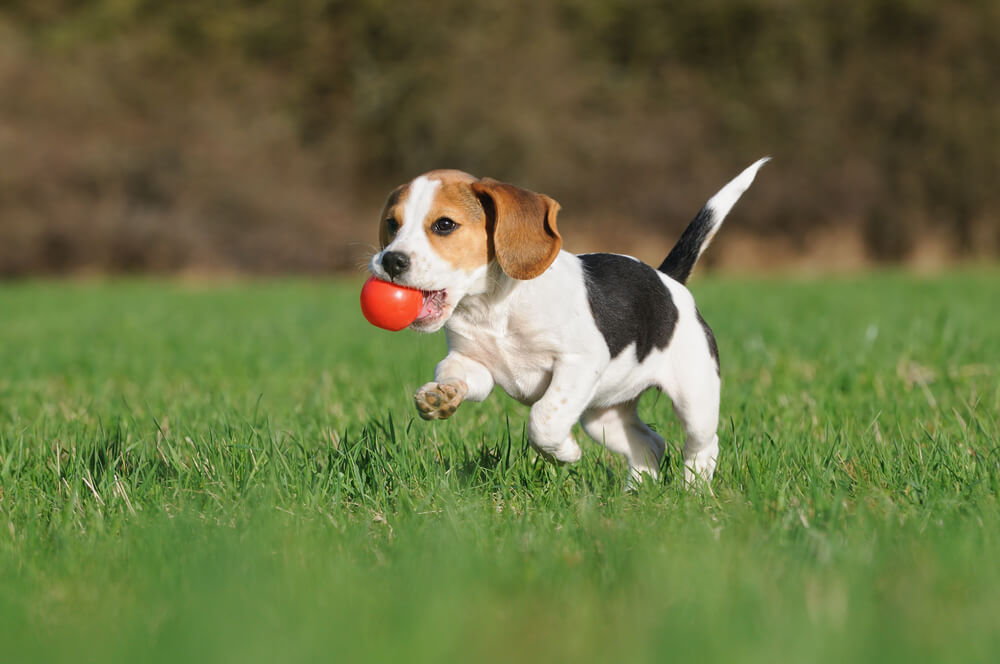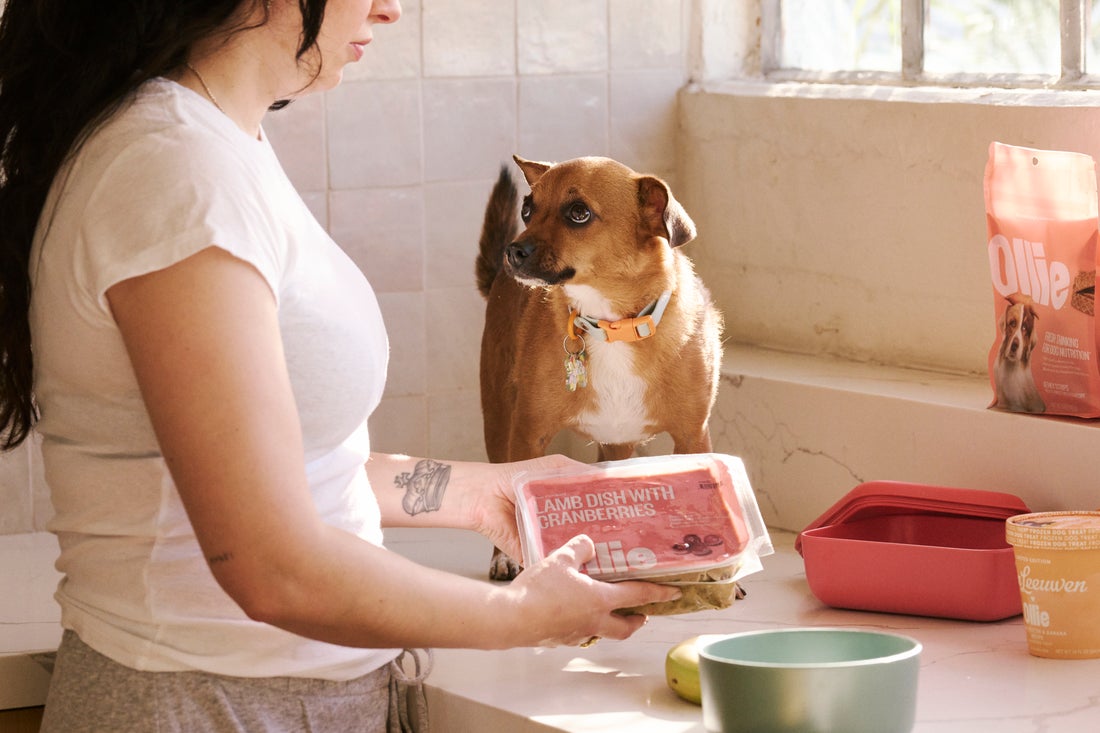Hey Ollie blog readers! We’re offering you an exclusive 60% OFF your starter box! Try now!
One second your dog seems fine, and the next, they’re hunched over, hacking up a pile of clear or white goo on your kitchen floor. If you’ve ever walked into a room and found a puddle of slimy mucus where your dog just was, you’re not alone—and it’s not always something to panic about.
Dogs vomit for a variety of reasons, and mucus is one of the more confusing things to see come up. It’s not as obvious as food or bile, and it often leaves pet parents asking the same questions: What does this mean? Should I be worried? Is there something I can do right now?
The short answer is: maybe, depending on the pattern and severity. While a single episode of mucus vomiting isn’t necessarily an emergency, recurring or severe symptoms can point to something more serious happening in your dog’s digestive or respiratory system.
In this guide, we’re breaking it all down—why dogs throw up mucus, what it looks like, what might be causing it, how to treat it, and when it’s time to call the vet. Whether you’ve just cleaned up a mess or you’re trying to prevent the next one, you’re in the right place.
What It Looks Like When a Dog Vomits Mucus
Not all dog vomit looks—or smells—the same. Mucus vomit is often clear, stringy, frothy, or slightly foamy. It may have a jelly-like texture or form puddles that don’t include food, bile, or blood. Sometimes, it’s white or slightly yellow-tinged, especially if it’s mixed with stomach acid or bile from an empty stomach.
This kind of vomit is usually made up of:
- Saliva
- Mucosal lining from the stomach or esophagus
- Stomach acid or digestive enzymes
In some cases, pet parents confuse vomiting with regurgitation or coughing up phlegm. Here’s how to tell the difference:
- Vomiting is active and involves retching or abdominal effort. Your dog might drool, heave, or pace beforehand.
- Regurgitation is passive. Food or fluid comes up with little warning or muscle effort.
- Coughing up mucus is more common with respiratory issues like kennel cough and is often followed by a gag or hack, not a full-body retch.
Understanding what type of mucus event you’re seeing can help narrow down the cause—and get your dog the right care faster.
Common Causes of Mucus Vomiting in Dogs
Dogs vomit mucus for a number of reasons—some are mild and short-term, others point to a bigger issue. Here are the most common causes and what each one might look like in real life.
Empty Stomach or Hunger Vomiting
If your dog tends to vomit clear or white foam in the early morning, it could be due to an empty stomach. This is especially common in small dogs, or those who go more than 10–12 hours between meals.
This type of vomit is usually made up of stomach acid, saliva, and mucus that builds up overnight. While it may look alarming, it’s not usually serious—though it might mean your dog needs a small bedtime snack or more frequent meals during the day.
According to VCA Animal Hospitals, dogs that vomit on an empty stomach are often experiencing what’s called bilious vomiting syndrome, a mild condition linked to excess stomach acid.
Dietary Indiscretion or Food Sensitivity
Sometimes, mucus shows up because your dog ate something they shouldn’t have. This could be anything from a greasy table scrap to a new treat or sudden switch in dog food.
The stomach reacts to irritation by producing extra mucus to protect the lining. The result? Slimy, foamy vomit—often with a side of regret. In other cases, food sensitivities to common ingredients like chicken, wheat, or soy can cause inflammation in the GI tract, leading to recurring mucus vomit.
When pets have an upset stomach or suffer from certain digestive issues such as inflammatory bowel syndrome, it is possible for them to suffer from more regular digestive issues such as vomiting mucus or yellow bile. As a dog parent it is important to understand your dog’s medical history and how that might impact their digestive system to understand the health issue. Veterinary attention can help you evaluate the different types of digestive issues with a physical examination.
This is one reason why a stable, whole-food diet matters. Highly processed or low-quality kibble can make sensitive stomachs more prone to inflammation—and the slimy mess that comes with it.
Kennel Cough or Respiratory Irritation
If the mucus your dog is vomiting looks more like thick phlegm, and it’s paired with a hacking cough, the issue might be respiratory—not digestive.
Kennel cough, or canine infectious respiratory disease complex (CIRDC), can cause dogs to cough so hard that they bring up foamy mucus or bubbly phlegm. In these cases, the mucus is coming from the throat or lungs, not the stomach.
You can learn more about the signs and treatment of CIRDC from Cornell University College of Veterinary Medicine.
Foreign Object or Blockage
If vomiting is frequent and mucus is showing up early in the process, it could mean your dog swallowed something they shouldn’t have—like a toy, bone fragment, or sock.
A blockage irritates the GI tract and may cause your dog to vomit repeatedly. At first, this can look like just mucus. But over time, you may see bile, undigested food, or even blood.
This situation requires immediate veterinary care. Don’t wait to “see if it passes.” If a blockage is suspected, an x-ray or ultrasound will likely be needed.
Parasites (Especially in Puppies)
Worms like roundworms or hookworms can irritate the gut and trigger vomiting—sometimes with mucus or a worm present in the vomit itself. Giardia, a common parasite picked up from puddles or shared water bowls, can also cause vomiting and mucus-filled diarrhea.
According to PetMD, signs of intestinal parasites can include vomiting, poor appetite, bloating, and mucus in the stool or vomit.
Regular deworming, clean drinking water, and avoiding high-risk areas for puppies can help lower the risk.
Acid Reflux or Chronic Gastritis
Some dogs have recurring inflammation in the stomach lining, known as gastritis, or suffer from acid reflux. Both conditions can trigger mucus vomiting, especially in the morning or after lying down.
This kind of vomiting is often cyclical and may come and go depending on what and when your dog eats. A high-quality diet—and consistent feeding schedule—can be a game-changer here.
When Is Vomiting Mucus a Serious Concern?
Not all mucus vomit is a red flag, but there are some clear signs it’s time to stop guessing and call your vet.
You should seek veterinary care if:
- Your dog vomits more than twice in 24 hours
- The mucus contains blood or appears dark and grainy (like coffee grounds)
- Your dog also shows signs of lethargy, loss of appetite, or fever
- Vomiting is paired with diarrhea, bloating, or weight loss
- The vomiting has gone on for more than a day, even if mild
Dr. Sara Ochoa, DVM, explains, “Repeated vomiting of mucus could signal a deeper issue like gastritis, pancreatitis, or even an intestinal blockage. It’s always better to check early rather than wait.”
Mild cases—especially those tied to an empty stomach or a one-time dietary slip—usually clear up on their own. But when in doubt, get it checked out. The earlier a serious condition is caught, the better the outcome.
What to Do if Your Dog Throws Up Mucus
The first step is to take a breath—especially if it only happened once. A single episode of mucus vomiting isn’t always an emergency. Your job now is to monitor closely, make smart adjustments, and keep an eye on your dog’s overall behavior.
Start with These Home Care Steps
1. Withhold food for 6–12 hours
Giving your dog’s stomach time to rest can help calm minor irritation. Make sure your dog still has access to fresh water during this time, unless vomiting continues after drinking.
2. Offer small amounts of water or ice chips
Too much water too fast can trigger more vomiting. Offer small sips or ice cubes every 30–60 minutes if your dog seems thirsty.
3. Slowly reintroduce a bland diet
If no more vomiting occurs after several hours, feed small portions of a bland diet: boiled chicken (no skin, no seasoning) and plain white rice is a safe choice. Feed in small amounts, spaced out over the day.
4. Watch for any other symptoms
Lethargy, diarrhea, bloating, or signs of abdominal pain should prompt a call to the vet—even if your dog seems okay otherwise.
5. Keep a log of when it started
Write down what your dog ate, when the vomiting happened, and how it looked. If you need to see a vet, this info helps guide their diagnosis.
What you shouldn’t do:
Don’t give your dog over-the-counter medications like Pepto-Bismol or Tums unless your vet has specifically advised it. Some human medications are toxic to dogs—even in small doses.
If vomiting returns after a bland meal, or if your dog refuses food completely, it’s time to involve a professional.
Treatment Options from Your Vet
If the vomiting doesn’t stop—or your dog is showing signs that something more serious is going on—your vet will step in to find out what’s causing the problem.
Here’s what they might do:
Physical Exam
Your vet will feel your dog’s abdomen for signs of pain, swelling, or abnormal masses. They’ll also check hydration levels and gum color to assess overall condition.
Diagnostic Testing
- Bloodwork can detect infections, pancreatitis, or liver and kidney function issues.
- X-rays or ultrasound can rule out blockages or foreign bodies in the GI tract.
- Fecal testing may be used to check for parasites or bacterial overgrowth.
Medical Treatment
- Antiemetics (anti-nausea meds) may be given to stop the vomiting.
- Subcutaneous or IV fluids may be needed if your dog is dehydrated.
- Deworming medication if parasites are identified.
- Antibiotics if there’s an infection present.
In mild cases, your vet may simply recommend a short-term bland diet and some rest. For dogs with chronic or recurrent vomiting, the next step could be a diet overhaul—or testing for allergies or gastrointestinal disease.
According to Merck Veterinary Manual, persistent vomiting may require advanced diagnostic procedures and should never be dismissed if symptoms repeat or worsen.
How Diet Plays a Role in Mucus Vomiting
Your dog’s digestive system is more sensitive than you might think—and what goes into their bowl has a direct impact on what might come back up.
Many cases of mucus vomiting are linked to dietary factors. These include:
- Poor-quality ingredients that irritate the gut
- Sudden food changes
- Inconsistent feeding times
- Sensitivities to common fillers like corn, wheat, or meat by-products
When the digestive system is inflamed or out of balance, the body may produce excess mucus as a protective mechanism. That’s what often ends up on your floor when your dog’s stomach can’t handle what they’ve eaten—or hasn’t eaten in too long.
Dogs with conditions like acid reflux, bilious vomiting syndrome, or food sensitivities often benefit from a fresh, whole-food diet that’s easy to digest and free from inflammatory triggers.
Ollie’s approach to food supports gut health in every bite:
- No fillers, artificial preservatives, or low-grade meat meals
- Fresh-cooked proteins like beef, chicken, turkey, or lamb
- Gut-friendly ingredients like pumpkin, carrots, sweet potatoes, and chia seeds
- Nutrient-rich fiber to support consistent, healthy digestion
- Pre-portioned meals to help avoid overeating and long fasts between meals
Many Ollie customers have seen improvements in their dogs’ digestion—especially in dogs with sensitive stomachs or frequent vomiting. And because we avoid common allergens and use only real, human-grade ingredients, we help take the guesswork out of what’s causing digestive stress.
If your dog is vomiting mucus regularly and your vet has ruled out serious illness, your dog’s food could be the missing piece of the puzzle. Learn about how Ollie Fresh Dog Food can help to improve digestion and overall health.
How to Prevent Your Dog from Vomiting Mucus
Preventing future episodes of mucus vomiting starts with a combination of smart habits, consistent nutrition, and knowing your dog’s unique sensitivities.
Here are some proven strategies:
1. Feed consistent, high-quality meals
Avoid skipping meals or long gaps between feeding times. Feeding twice a day (or more for small breeds) can prevent hunger vomiting caused by excess stomach acid.
2. Avoid sudden food changes
Introduce new food gradually over 5–7 days to allow your dog’s gut to adjust. Rapid switches can shock the digestive system and trigger mucus production.
3. Don’t share table scraps
Greasy or spicy human foods can irritate your dog’s stomach—even in small amounts. Keep high-fat or seasoned leftovers off the menu.
4. Supervise outdoor time
Many dogs will eat grass, mulch, or unknown scraps when outside. Keep a close eye out, especially if your dog is known for scavenging.
5. Use slow feeder bowls for fast eaters
Gulping food quickly increases the risk of vomiting, indigestion, and excess mucus production. Slow feeders encourage better chewing and digestion.
6. Keep a clean water bowl and limit access to puddles
Drinking from contaminated water sources can introduce parasites like Giardia, which often cause vomiting and mucus-laced diarrhea.
7. Prioritize gut-supportive ingredients
Foods with pumpkin, ginger, and prebiotic fibers can help reduce inflammation and balance the gut—both of which help prevent mucus vomit in the long run.
With the right food and a little daily awareness, most dogs prone to vomiting mucus can improve significantly—often within just a few weeks.
Try Ollie Dog Food For Improved Digestion
If your dog’s digestion seems off, or you’re tired of guessing what’s behind every episode of mucus vomiting, Ollie can help.
Our fresh, gently cooked meals are made with real, human-grade ingredients—no mystery fillers, no artificial junk. Just clean protein, nourishing veggies, and gut-friendly nutrients your dog actually needs.
Take our short quiz to get a personalized meal plan that supports your dog’s digestive health from the inside out.
Frequently Asked Questions (FAQ)
Why does my dog vomit mucus only in the morning?
Morning vomiting, especially when it’s clear or white and foamy, often happens when a dog’s stomach is empty for too long. This can cause bile and stomach acid to build up, irritating the lining and triggering vomiting. Feeding a small meal before bedtime can often help.
Is white foamy vomit the same as mucus?
They’re similar but not exactly the same. White foamy vomit often includes mucus mixed with stomach acid and air. Mucus vomit is typically more stringy or slippery and may appear clearer or thicker in texture.
Can allergies cause my dog to vomit mucus?
Yes. Food allergies or sensitivities can irritate the gut and lead to mucus production as the body tries to protect the stomach lining. Environmental allergies may also cause post-nasal drip or coughing that can look like mucus vomit.
Should I change my dog’s food if they vomit mucus regularly?
If your vet has ruled out a medical condition, diet could be playing a role. Many dogs respond well to fresh, limited-ingredient diets made with whole, digestible foods. A switch to Ollie’s fresh food has helped many dogs with chronic digestive issues find relief.
How can I tell the difference between vomit and regurgitation?
Vomit is active and usually involves retching or abdominal contractions. Regurgitation is passive—it happens suddenly without warning, often bringing up undigested food or liquid. Mucus can be present in both, but knowing the difference helps guide treatment.
Tagged As:

The nutrition your dog needs,
the food they want.

Enjoying our articles? Subscribe our Newsletters and get new articles directly to your inbox
You might also like
18 September 2025
4 MINS READ
Is Fresh Dog Food Easier to Digest?
Yes, fresh dog food is generally easier for dogs to digest than highly processed kibble. Because it’s made with whole ingredients, gently cooked, and free from unnecessary fillers, fresh food supp…
by Ollie Pets
18 September 2025
5 MINS READ
Can I Rotate Fresh Dog Food Flavors?
Yes, it’s safe to rotate fresh dog food flavors, and many dogs actually benefit from the variety. At Ollie, we offer multiple fresh recipes, like Beef, Chicken, Turkey, Lamb, and Pork so you can…
by Ollie Pets
18 September 2025
5 MINS READ
Is Fresh Dog Food Safe During Power Outages?
Fresh dog food is only safe during a power outage if it has stayed cold, specifically, below 40°F. Once the temperature rises above that point, bacteria can start to grow, and the food may no lon…
by Ollie Pets







